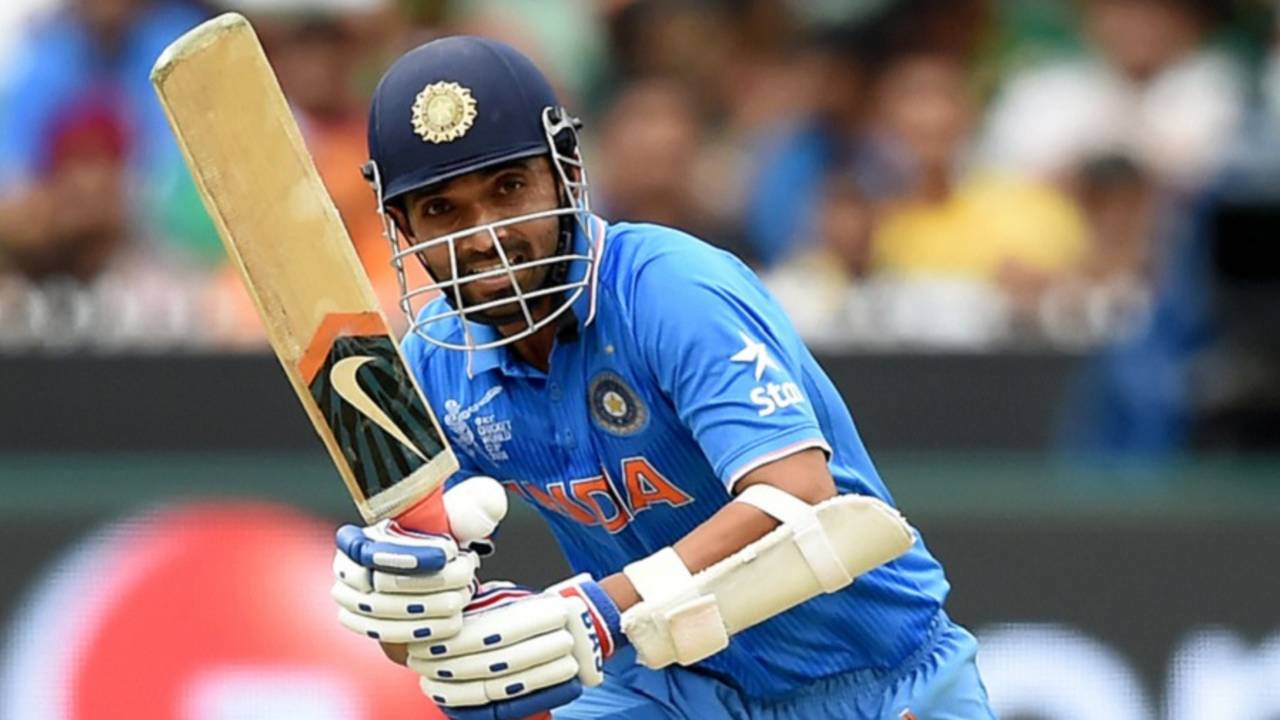MS Dhoni's
straight talk about
Ajinkya Rahane being left out of the second ODI against Bangladesh caused a bit of a stir. Rahane was found guilty of not being able to "freely rotate the strike", and there's no denying that Dhoni has been spot-on in his assessment of the batsman.
Among Indian batsmen in the subcontinent since Rahane's ODI debut in 2011:
● Rahane's
strike rate and singles percentage is the lowest
● His dot-ball percentage is the highest
● His
balls-per-boundary rate is well down the list
● He scores off only 42.7% of the balls he faces in the subcontinent in ODIs, which is the lowest rate
The average team innings score is increasing with every game. Three hundred and fifty has become the new 300, even in supposedly bowler-friendly conditions. The World Cup in Australia and New Zealand was a prime example. These days it's almost certain that unless you play aggressive cricket from the outset, you will not find a place in the side. Since the numbers suggest that Rahane isn't making the cut on the slow, low subcontinental pitches, he must wait for India to tour overseas to get a look in. Or at least that's what Dhoni has said.
But is it really as straightforward as the numbers suggest? Rahane has played
55 ODIs since his debut four years ago, of which he played only one in 2012 and six in 2013. He has batted at four different positions in his short career, ranging from opening the innings to as low down as No. 7, and has played one more game outside the subcontinent than he has in it.
Cold stats are a good indicator of many things but if a player's career is so nascent and his appearances so sporadic, it might be worth delving deeper and looking at other aspects too. Most of Rahane's below-par numbers in the subcontinent come from the early part of his career, and it would be unfair to ignore his evolution as a player since then. He
averages 36 since India's tour to England last year, and once again, he has opened and batted at numbers three, four and seven in this period. Taking that into account, Rahane's being dropped from Dhoni's XI is not only because of his poor showing but the changing dynamics in the batting order. If Dhoni wants to bat at No. 4, Rahane must bat at No. 5 or lower - where he is likely to be less effective. He is ideally suited to bat at the top, but if that is not an option, he must at least bat in the top four and not lower.
When top-order batsmen struggle, they move down the batting order. When finishers struggle, they move up the order. Dhoni's wish to bat at four is legitimate because he has always batted lower down the order, which is the toughest place to bat in an innings. At this stage of his career he should be allowed to take it a little easy. Also, for the team's success, Dhoni's presence in the XI is necessary, but on current form he must bat 20-plus overs to have an impact on the game. However, if this causes India's most improved player of the last 18 months to be sidelined, other options must be exercised.
Indeed, Indian cricket hasn't been very charitable to Rahane thus far. In 2013 he was given only one Test match at home, against Australia, before his spot was handed to Rohit Sharma for the next home series, against West Indies. He also was asked to bat at No. 6 in Tests till Rohit failed at five and vacated that spot. Now this.
Don't forget, Rahane was the
highest run scorer among Indians in the last season of the IPL too. My point is that he is improving and continuously adding new dimensions to his game, so it is worth being a little patient with him.
Who has not had problems at different stages of their career? Rohit was averaging 14 runs per innings at a strike rate of 73 in the 15 ODIs he played before he was made the regular opener. Raina was sent in at four against Australia in the high-scoring seven-match series at home in 2013, in which he scored a meagre 100 runs and was found out against the pace and bounce of Mitchell Johnson. But instead of being the door, he was promptly, and quite rightly, pushed down the order, for Raina is a valuable asset for India. If Rohit and Raina were given options, why can't Rahane be allowed to grow as an ODI cricketer by pushing him up to open with Shikhar Dhawan? Yes, it would mean Rohit batting at No. 5, but that is where he started his ODI career, and he is definitely better suited to finishing games off than Rahane. Plus, a middle order comprising Kohli, Dhoni, Rohit and Raina has a more formidable look.
Rahane has been
elevated to the captaincy for the short tour to Zimbabwe, and that is where he should stake a serious claim to the opening spot. He might be the senior statesman in this relatively inexperienced team and might be tempted to give everyone equal opportunities, but the importance of this series for his own ODI career must not be lost on him.

